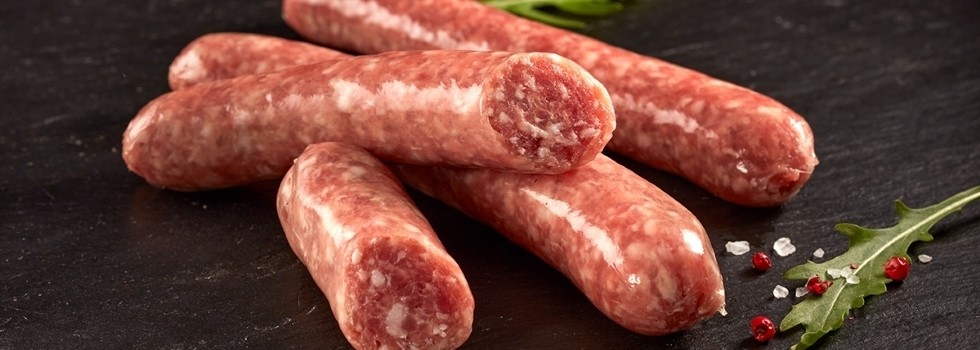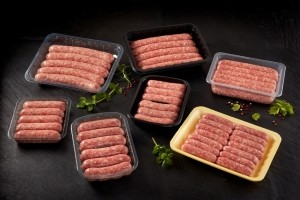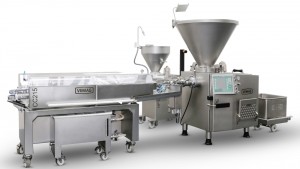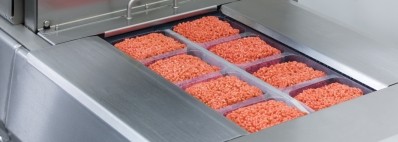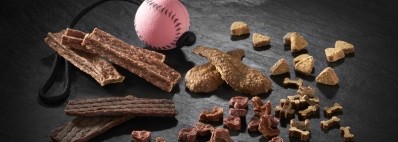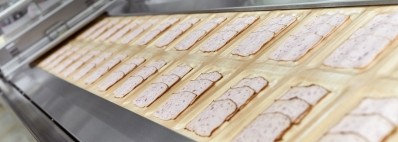Promotional Features
Why alginate has become the sausage casing of the future
According to a familiar proverb, necessity is the mother of invention and this rings just as true in the food and drink market as anywhere else.
For years, sausage manufacturers have debated the differing virtues of natural and artificial cases, with most coming down firmly on one side of the camp or the other. Yet, as consumption trends move on and today’s shoppers look for products that fulfil their expectations on myriad different fronts – from meat-based to flexitarian, vegan and vegetarian and from local provenance to sustainably sourced foods – the need for an alternative option has been growing momentum. And so, it was only a matter of time before the alginate casings market, based on a natural 100% vegan and sustainable product – seaweed – started taking off.
Although alginate casings have been around for some time, there has been a surge in the demand recently, reveals Ed Hewitt, field sales manager at equipment manufacturer Reiser UK. He puts this down to both improvements in the gel itself and the machinery technology coming together and making alginate casings a more accessible proposition to a much wider manufacturing audience. “Where we started to see this change was probably at least five or six years ago, but it’s only been in the past two years that we have seen a real explosion. That has been driven by increasing acceptance and understanding of alginate gel and companies like ours spending a lot of time with customers, testing and using taste panels to get them onside.”
Cost savings
In fact, so popular has alginate casing become that many of the sausage projects and installations Reiser now handles tend to be with alginate casing, for which the company has a wide range of solutions. “There’s still a market for the natural, collagen and cellulose casings, but companies are identifying more and more with what alginate can do for their product, process and bottom line,” he says.
So why has alginate casing become so popular? There are multiple reasons, but the cost saving on a variety of fronts is probably the biggest driving force.
Natural sheep casings are expensive and hog casings are catching them up, notes Hewitt. Meanwhile, meat processors are looking to become as efficient as they can be in terms of equipment speed and materials. “Certainly, when you are talking about moving from natural to alginate, the savings are considerable,” he says. “We’re talking a minimum 50% saving on other casings and, on natural, up to 75-80%. The numbers we are seeing with our customers amount to a substantial saving.”
Perhaps surprisingly, it’s not just the growing consumer interest in flexitarian, vegetarian and vegan diets that is driving the interest in alginate, he notes. “The bigger volume is with the meat market at the moment – purely because that’s where the volume production is. The plant-based side, much as it is growing, is relatively small by comparison.”
“Alginate, being seaweed-based is less intensive in terms of processing to get it to a more usable format”
There’s also the environmental saving, as much of the hog and sheep casing available is processed in China, so there is the transport aspect to consider. “Casing gets shipped out there, processed, shipped back, so this side is quite energy-hungry,” he adds. “Alginate, being seaweed based, is less intensive in terms of processing to get it to a more usable format. Alginate can also be supplied in powder form to the customer where they would add water and mix it to produce the gel. This greatly reduces the shipping costs and storage on-site for customers.”
Then, there’s the line speed. Whether natural, collagen or cellulose, traditional casing is a certain length and, once it comes to an end, the machine needs to be replenished, requiring a machine stop. With alginate, however, the process of gelatinisation occurs during the processing via the use of calcium chloride. So, as long as one hopper is full of gel and the other full of meat or plant-based ingredients, the system runs continuously. “You have the benefit that you don’t have the end or start to the casing which might have to be reworked or even wasted completely,” says Hewitt. “With alginate you don’t have that wastage and you can actually rework some of the product back into the base mix.”
An additional and important factor is that manufacturers can maintain the same calibre of casing from the beginning to end and the same length, points out Reiser product specialist Volker Fahldieck. “On natural casings, the calibre can vary, as it’s part of the intestine and can get bigger or smaller in different areas, plus the lengths can be different. The alginate casing is much easier to handle and you don’t have to watch the temperature as you do when you soak natural casings, for example.”
“As long as your alginate line is set up properly, then it is very consistent, giving consistent thickness and calibre,” agrees Hewitt. “You’re also eliminating mixed species. So, the problem with chicken sausages, for example, is that they will generally use collagen or sheep casing. Using alginate opens products up to halal markets or markets that might have been deprived previously because of the species of casing used.”
The speed of the continuous process on an alginate casing line also has other cost-saving implications. The number of operators needed to run the line is substantially reduced and a company can produce more in one go. This continuous line also lends itself more easily to automating other processes, such as feeding and trayloading, taking more operators out of the equation, effectively deskilling the process, and saving labour – an important equation in the UK market, where post-Brexit manufacturers are struggling to find sufficient employees to run their systems.
“But you might also be in a situation – which we’ve seen recently – where one alginate line can take over what used to be two or three older systems,” says Hewitt. “So you’re improving the floor space for the factory as well. That is huge in factories where floor space is at a premium.”
Customised casings
Comparatively speaking, alginate casing can also be customised and tailored to a client’s specific needs, explains Hewitt. “The tenderness, the clarity – there’s a level of tailoring that can be done. It’s not a case of one size fits all. So, for a customer, understanding that flexibility exists means they can really start to define what casing they want for a product rather than just accepting what the market has to offer them.”
“If you compare an alginate casing and natural casing side by side, they look very similar and are also similar in bite and texture,” adds Fahldieck. “That’s the beauty of it – they don’t look artificial.”
There is, Hewitt admits, still some way to go in persuading diehard sausage manufacturers to adopt alginate casing – particularly those who may have looked at it as an option some years ago, when the technology was not as advanced. However, he says that Reiser is starting to see smaller businesses, such as traditional catering butchers, take it into consideration. “They are now starting to see the benefits and the fact that the product, is good, saleable and their customers like it,” he says.
After all, satisfying the customer – whether on the catering or retail front – is the most important point for any manufacturer and here, too, the alginate option can make a difference, he argues. “For larger producers supplying into the multiples, they will have found that one of their customers’ main complaints will be about the casings – finding them too chewy and rejecting them from that point of view. But with alginate, the problem literally disappears overnight – we have seen the figures on this from a recent launch – and that’s a massive cost impact to a business.”
Bringing it all back to the equipment used to process sausages, an alginate system is “far simpler in terms of moving parts, mechanically”, says Hewitt. So stripping it down, hygiene and maintenance are all easier.
Reiser’s own alginate line, the Vemag CC215, has very few component parts to strip down and clean compared to some competitors who might have three to four times more parts as standard, he explains. The whole system is made from stainless steel and the CC215’s divider belt design provides the exact length of sausage required, ranging from 40mm-1400mm and calibres from 8mm to 32mm.
Another advantage of the divider belt system is that it avoids slippage when handling a product such as alginate, which naturally has liquid residue from the calcium chloride gelatinisation process.
“Our divider belt system also gives us far greater speed that anyone else on the market, because of the Vemag’s continuous running divider belts,” adds Hewitt. “We have far fewer moving parts and so less maintenance than other systems. With our system operating at our fastest speed – two metres per second – it’s industry-leading and we’re able to change product length in a matter of seconds, as well as calibre within a very short space of time.”
The Vemag’s double-screw technology allows the operator to run a very large range of product types on the same machine with few changes, so flexibility and weight accuracy are also key. The double screw can also utilise the Vemag ‘true inline grinding’ technology as part of the system to reduce steps in the preparation process and give the customer finite control on the finished product. Meanwhile the CC215 minimises its footprint by having the calcium chloride system positioned beneath the main body of the machine and the option to position the gel pump to the right or left depending on the production area.
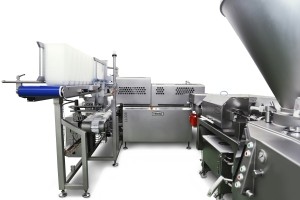
“The product path from the Vemag pump to the end of the coextrusion head is much shorter on an alginate sausage line compared to a traditional filling horn on a traditional casing holder,” adds Hewitt. “This means less pressure on the product during filling, so structure and particle definition are maintained.”
While alginate casing can be used on a wide range of sausage products, it works well on snacking sausages where drying, maturing and ageing are used and even on pet food sausages, where manufacturers are now showing an interest in the sector as the gel works well with drying and cooking processes for these products.
But whether it’s alginate casing line or another system, Reiser’s approach is to trial products with customers well before they get to market via its Milton Keynes-based test kitchen. “The most important thing is to test [products] – if possible in Milton Keynes first but then usually on-site as well. With alginate casing it’s important to understand how the gel and casing interact with the ingredients and tweak accordingly. We get to see any pitfalls before rubber-stamping everything. We want to understand the whole system back to front – what the customer does, how they do it, the product they are trying to produce and why they are doing so. If you understand that before you even start to make a product, you’re in a much better position.”
Reiser is so convinced by the benefits of alginate casing that, if a customer wants to run a natural or collagen casing trial, the company would offer to set up an alginate line next to it and run it at the same time – “just to contrast and compare, not to persuade them necessarily one way or the other, but show them the differences”, says Hewitt. “You have to make your customers aware of the latest technologies and we just see that as an extension of our service.”
Finally, it all comes down to the direction in which the food and drink manufacturing market is headed – a need to maximise efficiency, save on processing and labour costs, create greater sustainability in their operations and follow the emerging market trends dictated by the end-consumer. In the world of sausages, alginate casing systems have an answer to all those points.
For more details on the Vemag CC215 or how Reiser can help you maximise your productivity and efficiency contact fnyrfhx@ervfre.pbz.
For a closer look at the Vemag CC215 in action, see video below:
